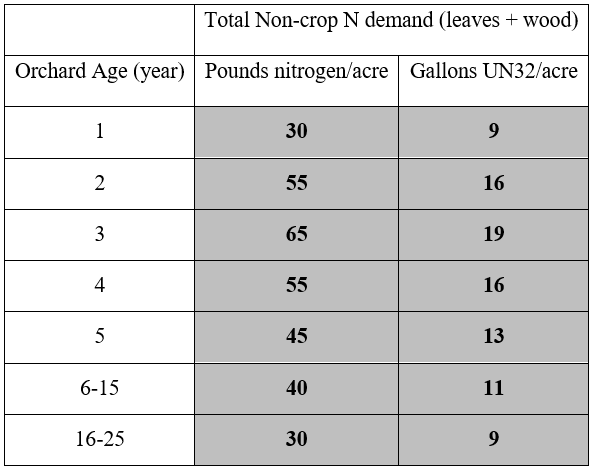Franz Niederholzer, UCCE Orchard Systems Advisor, Colusa and Sutter/Yuba Counties
Katherine Jarvis-Shean, UCCE Orchard Systems Advisor, Sacramento, Solano and Yolo Counties
Luke Milliron, UCCE Orchard Systems Advisor, Butte, Glenn, and Tehama Counties
Curt Pierce, UCCE Water Resources Advisor, Glenn, Tehama, Colusa and Shasta Counties
Crop load is the major driver in nitrogen (N) and potassium (K) and phosphorus (P) use in an orchard. Those nutrients also make up most of the fertilizer cost/acre. In a light crop year following frost, fertilizer savings are possible, but some fertilizer, especially N should be applied to maintain orchard health and crop potential for next year.
Where frost hit the crop, significant savings will be possible by reducing the nitrogen rate (lbs. N/acre). The overall strategy is the same as for a good crop. Apply N from March to early June, following the pattern of tree and nut demand; some N early, peak demand in late April/May and easing off by June. The trees use 40 lbs. N/acre regardless of the crop (see the table below for tree N needs per acre without crop), but the lighter crop means less N for the year. With less crop in the tree, less N is needed. The crop uses 68 lbs. N/1000 lb. kernel crop). For example, a tenth leaf orchard with a light crop (1000 lb. kernel/acre) due to frost should use 108 lbs. N/acre instead of the 210 lbs. N/acre used to feed a normal crop (2500 lbs. kernel/acre). Check irrigation water nitrate levels for “free” N and subtract that from the gross orchard N need. Keeping up with N will maintain spur and shoot growth this year and flower production for next year.
What about nutrients other than N? Cropload is the major driver of orchard potassium (K) use, so a light cropload will lessen the need for this essential nutrient. If orchard leaf K level was adequate in 2021 and some K fertilizer applied last year or during the winter, little if any K will be needed this year in orchards with low set due to freeze. Phosphorus, too, should be a very low priority fertilizer unless the orchard has a history of low levels of this nutrient (<0.1% leaf P). [Crop K and P levels are roughly 90-100 lbs. K2O and 23 lb. P2O5 per 1000 lbs. of kernel crop.] A May or June leaf analysis compared to July levels is a good way to check orchard K status with some time left in the season to add some K to avoid deficiency going into the fall. Micronutrients such as zinc and boron are most needed at bloom, so apply as needed this year, based on summer leaf and harvest hull tissue analysis, respectively, to prep the orchard for 2023.

Tree (Leaves, shoots and wood) nitrogen (N) use at different ages presented as pounds N/acre or gallons UN32 (32-0-0) for an example orchard of 14’ x 22’ spacing; 145 trees/acre. Data do NOT include crop N demand. Crop demand is an additional 68 lbs N/1000 lbs kernel crop. Data is from Nitrogen Best Management Practices (almonds.com/almond-industry/orchard-management/soil-health-and-nutrients/nutrient-management)


Leave a Reply